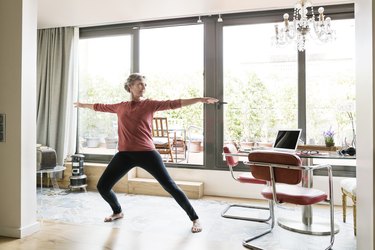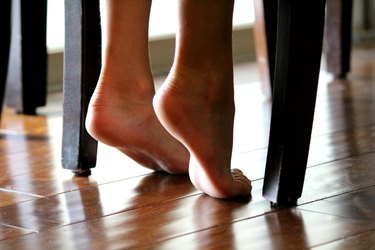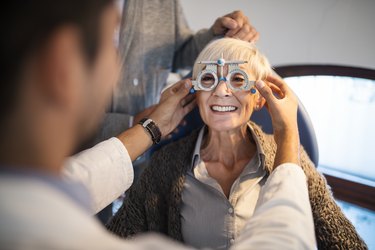
If you're over 65 or have a loved one who is, you may worry about falls, and for good reason: They're the leading cause of fatal and nonfatal injuries among older adults, according to the Centers for Disease Control and Prevention (CDC).
They're also on the rise: Fall death rates increased 30 percent from 2007 to 2016, and if this trend continues, the CDC estimates there will be seven fall deaths every hour by 2030. And experts say the number may only go up post-pandemic.
Video of the Day
Video of the Day
"Anecdotally, we're seeing an increase in falls because of the isolation so many older adults have gone through," says Kathy Wyle, PT, a physical therapist for Granite VNA in Concord, New Hampshire. "Many seniors weren't able to even leave their homes, so their activity level really dropped, which affected their strength and balance. Not to mention that if people begin to feel unstable, that can lead to a fear of falling, so they go into a spiral of doing less and less, which only worsens the problem."
While there's no guarantee you'll never take a tumble, there are things you can do to help prevent falls and their resulting injuries. Here are five ways.
1. Fall-Proof Your Home
You may feel like home is the safest place to be, but in reality, 6 out of 10 falls happen at home, according to the National Institute on Aging.
But this risk can go down if you take a few basic safety precautions like de-cluttering, installing handrails and putting in some better lighting, notes Alexander Garbin, PT, DPT, PhD, a postdoctoral fellow in the department of physical medicine and rehabilitation at the University of Colorado Anschultz Medical Campus.
Garbin and the National Institute on Aging recommends the following:
- Install handrails on both sides of all stairs, and use them (if you need to carry something, hold it in one hand and use the handrail with the other.)
- Make sure there is good lighting with light switches at the top and bottom of stairs and at the ends of hallways. Keep night lights in your bedroom and bathroom.
- Don't leave books, papers, clothes or shoes on floors or stairs.
- Don't use throw rugs or small area rugs, which you can trip on, says Garbin. Make sure carpets are fixed firmly to the floor, and put no-slip strips on non-carpeted areas (you can get them at the hardware store).
- Place grab bars near toilets and on both the inside and outside of your tub and shower.
- Keep items you frequently use within easy reach. If you need to get something that's too high, use a "reach stick," which is a special grabbing tool you can buy at the hardware store. Don't use a step stool unless you have someone standing next to you.
- Know where your pet is when you're standing up or walking, so they don't trip you.
If you've already fallen, your doctor may put in a referral for an occupational therapist or nurse to come to your house to assess its safety. You can also check with your local health department, or local Area Agency on Aging, to see if they have any programs to help with modifications.
2. Stay Strong

Muscle weakness is a big cause of falls.
"Your leg muscles, especially your calf, hip and knee muscles, are especially important, because if you were to trip or slip, those are the muscles that catch you," explains Garbin.
This is especially true when you're outside and walking on uneven surfaces, which are more of a balance challenge, he notes.
You can get benefits from basic physical exercise like walking, says Cathy Ciolek, PT, DPT, a spokesperson for the American Physical Therapy Association and president of Living Well with Dementia, a geriatric physical therapy center in Wilmington, Delaware.
You can also do these simple strength exercises at home, from the U.S. Library of Medicine, most days of the week. Do each one 10 to 15 times:
Toe Stand
Strengthens: Calves and ankles
Hold on to the back of a chair and push up onto your tiptoes as high as you can, then slowly lower your heels back down.
Knee Curl
Strengthens: Butt and lower back
Hold on to the back of a chair, and lift one leg straight back behind you, then bend your knee and bring your heel towards your butt before lowering it back to your starting position.
Leg Extension
Strengthens: Thighs
Sit in a straight-back chair with your feet on the floor. Straighten one leg out in front of you as much as possible, then lower it back down.
3. Build Up Your Balance
Good balance is important to prevent falls, because it helps you control and maintain your body's position, Ciolek says. One great way to improve your balance is practicing tai chi: A July 2017 review in the Journal of the American Geriatrics Society found that it cuts your risk of falls in half and may be even more effective than other forms of fall prevention like physical therapy.
Other good balance exercises are standing on one foot, walking heel-to-toe and even standing from a seated position, Ciolek adds.
Another easy exercise you can do even in front of the TV: Simply stand up and, holding onto a sofa or chair for support, sway side to side. "It shifts weight over each leg, which helps build balance, strength and even confidence," Wyle says.
Related Reading
4. Watch Your Meds
Two-thirds of older adults rely on at least two prescription drugs, and 20 percent take at least five, according to the 2020 National Poll on Healthy Aging. But the more drugs you take, the more at risk you are for side effects such as dizziness or low blood pressure, which can lead to you taking a tumble, says Nisha Rughwani, MD, an associate professor of geriatrics and palliative care at the Icahn School of Medicine at Mount Sinai.
Case in point: Folks who take more than four prescription drugs account for almost a quarter of all falls that lead to hospitalization, according to a November 2020 study in BMC Public Health. Some of the most common meds are:
- Anti-anxiety meds like diazepam (Valium) and lorazepam (Ativan)
- Drugs to treat overactive bladder, like oxybu-tynin (Ditropan) and tolterodine (Detrol)
- Prescription sleep medications like zolpidem (Ambien), zaleplon (Sonata) and eszopiclone (Lunesta)
- Tricyclic antidepressants such as amitriptyline (Elavil), which are sometimes prescribed to relieve chronic pain
- Opioids like hydrocodone (Vicodin), oxycodone (Percodan, Percocet) or fentanyl (Duragesic)
- Over-the-counter sedating antihistamines such as diphenhydramine (Benadryl)
It's always a good idea to do a yearly medication review with your primary care doctor or pharmacist, to see if you're taking anything that could potentially raise your risk of falls.
"This is especially important now during the pandemic, because a lot of older adults were prescribed anti-anxiety medications and sleeping pills to help them cope during this stressful time," Dr. Rughwani notes.
5. Get Your Vision and Hearing Checked

Even small changes in sight and hearing may make you more susceptible to falls, says William Buxton, MD, neurologist and director of Neuromuscular and Neurodiagnostic Medicine and Fall Prevention at Pacific Neuroscience Institute at Providence Saint John's Health Center in Santa Monica, California.
Impaired vision more than doubles this risk, according to the CDC, which recommends that all older adults get a dilated eye exam at least once a year to prevent irreversible vision loss and to update your glasses prescription if it's needed.
And even mild hearing loss triples the risk of an accidental fall, according to a February 2013 study in the Archives of Internal Medicine.
"There are a couple reasons why, the main one being that hearing loss makes people less aware of their environment, so they may not notice something like a pet or an object near them," Dr. Buxton explains. "But if you're straining to hear, your brain is using all of its energy towards trying to interpret speech, so it's not devoting as much attention to your balance."
As a result, you're more likely to stumble and ultimately fall.
What to Do if You Fall
If you do take a tumble, here's what to do, Ciolek says:
- Try not to panic. Take a few deep breaths until you've calmed down.
- If you can get up, roll over onto your side, then slowly get up on your hands and knees and crawl over to a chair. Put your hands on the seat so you're in a kneeling position, then slowly rise up and turn your body to sit in the chair. This will help prevent you getting up too quickly, which could make you dizzy and cause you to fall again.
- If you appear hurt — you're in pain, have hit your head or feel dizzy or nauseous — call 911.
- Even if you feel OK, it's still a good idea to call your doctor. They can ask you some questions over the phone and determine whether you should be evaluated in their office.
Related Reading
- Centers for Disease Control and Prevention: "Older Adult Falls Data."
- National Institute on Aging: "Fall-Proof Your Home."
- US National Library of Medicine: "Exercises to Prevent Falls."
- Journal of the American Geriatric Association: "Tai-chi For Risk of Falls. A Meta-Analysis."
- National Poll on Healthy Aging: "Older Adults' Experiences with Comprehensive Medication Reviews."
- BMC Public Health: "Polypharmacy is a risk factor for hospital admission due to a fall: evidence from the English Longitudinal Study of Ageing."
Is this an emergency? If you are experiencing serious medical symptoms, please see the National Library of Medicine’s list of signs you need emergency medical attention or call 911.